The Tech-Noir confrontation scene is a study of screen suspense. It comes at a moment when the audience has been waiting nearly 35 minutes to figure out what is going on. All we know is that two nameless characters (Schwarzenegger and Biehn) are in pursuit of Sarah Conner (Linda Hamilton). We do not know the intentions behind their pursuit. In the Tech-Noir scene, these three characters collide, finally — but it is not so much the collision itself that interests us. Rather, it is the build-up to that collision. Cameron uses careful pacing, editing, soundtrack manipulation and time expansion to increase the suspense of this scene. What follows is a shot-by-shot breakdown and analysis of the Tech-Noir scene.
 These
three images represent one continuous shot (Shot One), and
also the longest shot of the sequence. It is a reverse tracking shot
following the terminator, as he enters the nightclub and breaks the hand
of a bouncer who has a problem with the fact that the terminator didn't
pay the cover charge. Tryanglz "You've Got Me Burning" plays in the
club's sound system (source music), and the instant that the terminator
walks through the door, the strong chorus line to that rock song begins,
giving the image a powerful aural correlation.
These
three images represent one continuous shot (Shot One), and
also the longest shot of the sequence. It is a reverse tracking shot
following the terminator, as he enters the nightclub and breaks the hand
of a bouncer who has a problem with the fact that the terminator didn't
pay the cover charge. Tryanglz "You've Got Me Burning" plays in the
club's sound system (source music), and the instant that the terminator
walks through the door, the strong chorus line to that rock song begins,
giving the image a powerful aural correlation. 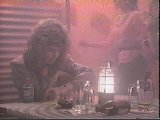 In Shot Two, we get a medium shot of Sarah sitting alone
at her table, and she is obviously paranoid. Now at this
point, we know more than Sarah: we know the terminator just killed her
roommate and that he has arrived at the nightclub. Our tension is
increased because we don't know when she will discover this threat.
In Shot Two, we get a medium shot of Sarah sitting alone
at her table, and she is obviously paranoid. Now at this
point, we know more than Sarah: we know the terminator just killed her
roommate and that he has arrived at the nightclub. Our tension is
increased because we don't know when she will discover this threat. 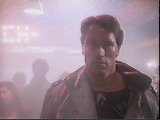 In Shot Three, we go back to the terminator for a moment,
to continue his progress through the nightclub. The suspense dynamics
of this scene are complicated; not only do we know more than Sarah, but
we also know more than the terminator, since we know where Sarah is sitting
but the cyborg hasn't discovered that yet. We deduce that the terminator
wants to kill Sarah, but we don't know why. And we still don't know
what Reese (Michael Biehn) is doing in all this mess. So, ultimately,
we understand the geography of the characters, but not their motivations.
In Shot Three, we go back to the terminator for a moment,
to continue his progress through the nightclub. The suspense dynamics
of this scene are complicated; not only do we know more than Sarah, but
we also know more than the terminator, since we know where Sarah is sitting
but the cyborg hasn't discovered that yet. We deduce that the terminator
wants to kill Sarah, but we don't know why. And we still don't know
what Reese (Michael Biehn) is doing in all this mess. So, ultimately,
we understand the geography of the characters, but not their motivations. 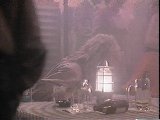 In Shot Four, we return to Sarah. She looks over her
left shoulder, probably searching for Reese, whom she saw following her
earlier. From previous visual cues, we know that she thinks Reese
is potentially the man trying to kill her. As she turns back around,
she accidentally knocks over her drink. It falls to the floor.
In Shot Four, we return to Sarah. She looks over her
left shoulder, probably searching for Reese, whom she saw following her
earlier. From previous visual cues, we know that she thinks Reese
is potentially the man trying to kill her. As she turns back around,
she accidentally knocks over her drink. It falls to the floor.
In Shot Five, we get a new angle on Sarah as she reaches
down to pick up her drink. Now she does this action at the
exact moment that the terminator walks by, glancing in her direction.
All this action is composed in one uninterrupted shot. 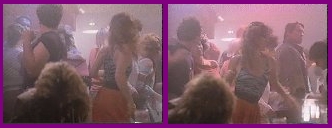 It is deus ex machina, a sheer coincidence which allows her to remain
unnoticed for a few moments longer. This use of deus ex machina
is excusable, however, since it does not ultimately save her; it only draws
out the scene a bit longer, increasing the tension. Also, this shot
is the beginning of the first use of slow motion, as well as soundtrack
manipulation. The song isn't slowed down, but it is distorted, enhanced
with some kind of reverberation effect.
It is deus ex machina, a sheer coincidence which allows her to remain
unnoticed for a few moments longer. This use of deus ex machina
is excusable, however, since it does not ultimately save her; it only draws
out the scene a bit longer, increasing the tension. Also, this shot
is the beginning of the first use of slow motion, as well as soundtrack
manipulation. The song isn't slowed down, but it is distorted, enhanced
with some kind of reverberation effect. 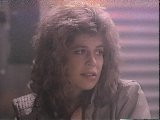 At
this point, the audience is torn: we want Sarah to live, but at the same
time we want the terminator to find her, because that will make for a more
exciting movie.
At
this point, the audience is torn: we want Sarah to live, but at the same
time we want the terminator to find her, because that will make for a more
exciting movie.
In Shot Six, we get a close-up on Sarah from a new angle
as she sits back up. Something has caught her eye. We see what
she is looking at in Shot Seven, a reverse angle, also Sarah's
point-of-view (P.O.V.) of Reese, sitting at the bar. 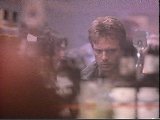 Reese stares directly into the camera, a point-of-view technique which
allows us to feel Sarah's fear: she is staring into the eyes of the man
whom she believes wants to kill her. She's wrong — Reese is her savior,
but she doesn't know that yet, and neither do we (unless we've already
seen the movie.) We are further frustrated, because we want Reese
to do something, but he just sits there and looks guilty. Also, during
this shot, Brad Fiedel's score makes an appearance into the soundtrack,
underlying the Tryanglz song. It is the four low repeating beats
which represent the terminator's theme, used here to associate Reese with
danger.
Reese stares directly into the camera, a point-of-view technique which
allows us to feel Sarah's fear: she is staring into the eyes of the man
whom she believes wants to kill her. She's wrong — Reese is her savior,
but she doesn't know that yet, and neither do we (unless we've already
seen the movie.) We are further frustrated, because we want Reese
to do something, but he just sits there and looks guilty. Also, during
this shot, Brad Fiedel's score makes an appearance into the soundtrack,
underlying the Tryanglz song. It is the four low repeating beats
which represent the terminator's theme, used here to associate Reese with
danger. 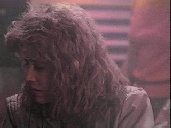 From Sarah's perspective, Reese is a threat ... he is death. In Shot
Eight, we return to the same close-up angle of Shot Six, to show
her reaction to seeing Reese: fear. She looks away. This is
typical ABA continuity editing: you show Sarah, then you show what she's
looking at, then you go back to Sarah for her reaction.
From Sarah's perspective, Reese is a threat ... he is death. In Shot
Eight, we return to the same close-up angle of Shot Six, to show
her reaction to seeing Reese: fear. She looks away. This is
typical ABA continuity editing: you show Sarah, then you show what she's
looking at, then you go back to Sarah for her reaction.
This analysis page is still under construction. Please return
back in a few days to see the rest of the sequence. Thank you for
your patience.